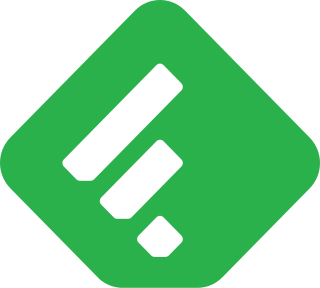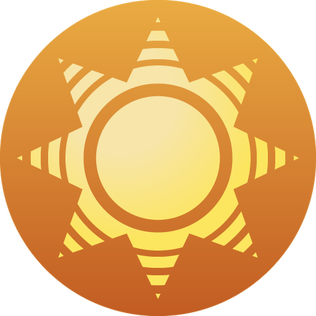Related Research Articles
RSS is a web feed that allows users and applications to access updates to websites in a standardized, computer-readable format. These feeds can, for example, allow a user to keep track of many different websites in a single news aggregator. The news aggregator will automatically check the RSS feed for new content, allowing the list to be automatically passed from website to website or from website to user. This passing of content is called web syndication. Websites usually use RSS feeds to publish frequently updated information, such as blog entries, news headlines, or episodes of audio and video series. RSS is also used to distribute podcasts. An RSS document includes full or summarized text, and metadata, like publishing date and author's name.
The name Atom applies to a pair of related Web standards. The Atom Syndication Format is an XML language used for web feeds, while the Atom Publishing Protocol is a simple HTTP-based protocol for creating and updating web resources.
On the World Wide Web, a web feed is a data format used for providing users with frequently updated content. Content distributors syndicate a web feed, thereby allowing users to subscribe a channel to it by adding the feed resource address to a news aggregator client. Users typically subscribe to a feed by manually entering the URL of a feed or clicking a link in a web browser or by dragging the link from the web browser to the aggregator, thus "RSS and Atom files provide news updates from a website in a simple form for your computer."
NetNewsWire is a news aggregator for macOS and iOS.
Handmark is a developer and distributor of mobile content, based in Kansas City, Missouri. The company was created in 2000 by the merger of Mobile Generation Software with Palmspring Software.

In computing, a news aggregator, also termed a feed aggregator, feed reader, news reader, RSS reader or simply an aggregator, is client software or a web application that aggregates syndicated web content such as online newspapers, blogs, podcasts, and video blogs (vlogs) in one location for easy viewing. The updates distributed may include journal tables of contents, podcasts, videos, and news items.

Google Reader was an RSS/Atom feed aggregator operated by Google. It was created in early 2005 by Google engineer Chris Wetherell and launched on October 7, 2005, through Google Labs. Google Reader grew in popularity to support a number of programs which used it as a platform for serving news and information to people. Google closed Google Reader on July 1, 2013, citing declining use.
This is a list of blogging terms. Blogging, like any hobby, has developed something of a specialised vocabulary. The following is an attempt to explain a few of the more common phrases and words, including etymologies when not obvious.

My Yahoo! is a start page or web portal which combines personalized Yahoo! features, content feeds and information. The site was launched in 1996 and was one of the company's most popular creations.
Pull coding or client pull is a style of network communication where the initial request for data originates from the client, and then is responded to by the server. The reverse is known as push technology, where the server pushes data to clients.
The following is a comparison of RSS feed aggregators. Often e-mail programs and web browsers have the ability to display RSS feeds. They are listed here, too.
GENWI is a privately held technology company based in San Jose, CA that provides a mobile content enablement platform.
Flud was a social news reader application for iPad, iPhone, Android and Windows Phone. It was designed to display RSS feeds from blogs and news sites into individual streams for easy viewing. In Flud, articles and stories could be stored for later reading with the Reading List, shared as a favorite read with the Flud button, and shared with Facebook, Twitter, email, Tumblr, Instapaper, and ReadItLater. Flud was headquartered in the historic Spreckels Theater Building in San Diego, California, with remote offices in Detroit and Chicago.

Feedly is a news aggregator application for various web browsers and mobile devices running iOS and Android. It is also available as a cloud-based service. It compiles news feeds from a variety of online sources for the user to customize and share with others. Feedly was first released by DevHD in 2008.

Free Malaysia Today (FMT) is an independent, bilingual news online portal with content, in both English and Bahasa Malaysia (Maylay), with a focus on Malaysian current affairs, published since 2009. It is one of Malaysia's most accessed news sites with monthly visits of 11.83 million।

NewsBlur is an American software company based in New York City and San Francisco. It runs an online RSS news reader service accessible both online and via a free open-source mobile app for offline reading. Furthermore, the software powering NewsBlur is available and is published in an open-source application, licensed under the MIT License. Limited access to the service is free for up to 64 sites; unlimited access is available for an annual subscription fee.

Digg Reader was a news aggregator operated by Digg. The reader was released on June 26, 2013 as a response to Google Reader shutting down. The reader is web-based and also has iOS and Android applications as well as a Google Chrome extension. The beta for the reader has received mostly positive reviews. On March 26, 2018, Digg shut down Digg Reader.
The Old Reader is a web-based news aggregator that delivers website, blog, and other Internet content to a web-based inbox. The service sprung up when Google removed social features from Google Reader; the site supports social media sharing, including the ability to "like" content, and find friends via social media networks.
Inoreader is a web-based content and RSS feed reader, a cloud-based service for web browsers and mobile devices running iOS and Android. It compiles news feeds from online sources for the user in unified layout to customize and share with others. Inoreader was first released by Innologica in 2013.

Apple News is a mobile app and news aggregator developed by Apple Inc., for its iOS, iPadOS, watchOS, and macOS operating systems. The iOS version was launched with the release of iOS 9. It is the successor to the Newsstand app included in previous versions of iOS. Users can read news articles with it, based on publishers, websites and topics they select, such as The New York Times, technology or politics.
References
- ↑ "BazQux Reader Mini Review". Donationcoder. Retrieved July 7, 2020.
- ↑ "Feedme Android App". Bazqux Reader Blog. Retrieved July 7, 2020.